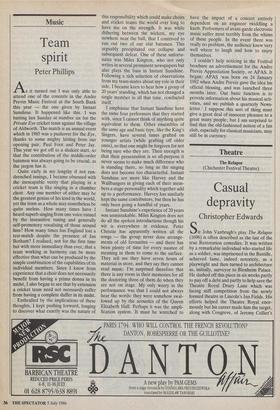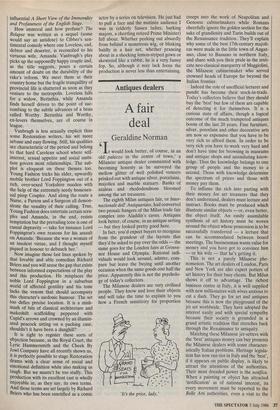Theatre
The Relapse (Chichester Festival Theatre)
Casual depravity
Christopher Edwards
Sir John Vanbrugh's play The Relapse (1696) is often described as the last of the true Restoration comedies. It was written by a remarkable individual who started life as a soldier, was imprisoned in the Bastille, achieved fame, indeed notoriety, as a playwright and then turned to architecture as, initially, surveyor to Blenheim Palace. He dashed off this piece in six weeks partly to pay off a debt and partly to help save the Theatre Royal Drury Lane which was facing stiff competition from the newly formed theatre in Lincoln's Inn Fields. His efforts helped the Theatre Royal enor- mously but his career made him the target, along with Congreve, of Jeremy Collier's influential A Short View of the Immorality and Profaneness of the English Stage. How immoral and how profane? The Relapse was written as a sequel (some would say an antidote) to Cibber's sen- timental comedy where one Loveless, cad, debtor and deserter, is reconciled to his virtuous wife, Amanda. Vanbrugh's play picks up the supposedly happy couple and, as the title suggests, pours a certain amount of doubt on the durability of the rake's reform. We meet them at their country home but the fragile tranquillity of provincial life is shattered as soon as they venture to the metropolis. Loveless falls for a widow, Berinthia, while Amanda finds herself driven to the point of suc- cumbing to the subtle advances of a beau called Worthy. Berinthia and Worthy, ex-lovers themselves, are of course in league.
Vanbrugh is less sexually explicit than some Restoration writers, his wit more urbane and easy flowing. Still, his qualities are characteristic of the period and belong to that hard Carolean school where self- interest, sexual appetite and social ambi- tion govern most relationships. The sub- plot is eloquent on these themes too. Young Fashion tricks his elder, upwardly mobile brother Lord Foppington out of a rich, over-sexed Yorkshire maiden with the help of the extremely seedy homosex- ual pimp Coupler. And along the route a Nurse, a Parson and a Surgeon all demon- strate the venality of their calling. True, Young Fashion does entertain certain scru- ples and Amanda, in the end, resists temptation but the prevailing tone is one of casual depravity — take for instance Lord Foppington's own reasons for his assault on Amanda: 'Because she was a woman of an insolent virtue, and I thought myself piqued in honour to debauch her.'
Now imagine those last lines spoken by that lovable and able comedian Richard Briers and you will sense the gap that exists between informed expectations of the play and this production. He misplaces the noble Lord Foppington in a suburban world of affected gentility and his tone lacks the venom that should accompany this character's sardonic humour. The set too defies precise location. It is a mish- mash of bits of classical architecture and makeshift scaffolding peppered with Cupid's arrows and crowned by an illumin- ated peacock sitting on a packing case; shouldn't it have been a dunghill? It is right to register these sorts of objection because, as the Royal Court, the Lyric Hammersmith and the Cheek By Jowl Company have all recently shown us, it is perfectly possible to stage Restoration drama with a clear sense of social and emotional definition while also making us laugh. But we mustn't be too stuffy. This production with its excellent cast is wholly enjoyable in, as they say, its own terms. And those terms are set largely by Richard Briers who has been sanctified as a comic actor by a series on television. He just had to pull a face and the matinee audience I was in (elderly Sussex ladies, barking majors, a chortling retired Prime Minister) fell about. Whether peeking out absurdly from behind a monstrous wig, or blinking baldly in a hair net, whether prancing about in a shocking lemon-striped gown or skewered like a rabbit, he is a very funny fop. So, although it may lack focus the production is never less than entertaining.



















































 Previous page
Previous page